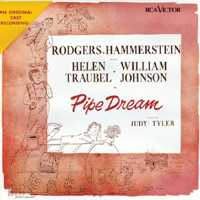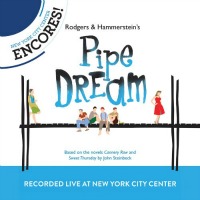 Original Broadway Cast, 1955 (RCA)
Original Broadway Cast, 1955 (RCA)  (3 / 5) Rodgers and Hammerstein may not have been the ideal team to put the chippies and layabouts of John Steinbeck’s Cannery Row onstage in a musical; it’s tantalizing to consider what Frank Loesser, who was first approached to adapt Steinbeck’s Sweet Thursday, would have wrought. Still, the score of the shortest-running R&H Broadway show is lovely, full of Oscar Hammerstein’s humanity and Richard Rodgers’ surprising melodic turns. Listen to the composer’s wondrous harmonics in “Suzy Is a Good Thing,” for example. Evidently, Helen Traubel’s whorehouse madam failed to convince in the theater, but she’s fine on disc. Even better are the young lovers, the soulful Judy Tyler and the always reliable William Johnson, genuinely sexy together and apart. As for the choral ensembles, they’re lively and lusty. The overture is incomplete here; the second verses of each song, even the excellent “The Man I Used to Be,” are missing; and the album is capped by an illogical finale that crams as many hopeful hits as possible into a few minutes. But the recording is valuable as an aural document of the original production of a rare flop from a team that was much more used to great success. — Marc Miller
(3 / 5) Rodgers and Hammerstein may not have been the ideal team to put the chippies and layabouts of John Steinbeck’s Cannery Row onstage in a musical; it’s tantalizing to consider what Frank Loesser, who was first approached to adapt Steinbeck’s Sweet Thursday, would have wrought. Still, the score of the shortest-running R&H Broadway show is lovely, full of Oscar Hammerstein’s humanity and Richard Rodgers’ surprising melodic turns. Listen to the composer’s wondrous harmonics in “Suzy Is a Good Thing,” for example. Evidently, Helen Traubel’s whorehouse madam failed to convince in the theater, but she’s fine on disc. Even better are the young lovers, the soulful Judy Tyler and the always reliable William Johnson, genuinely sexy together and apart. As for the choral ensembles, they’re lively and lusty. The overture is incomplete here; the second verses of each song, even the excellent “The Man I Used to Be,” are missing; and the album is capped by an illogical finale that crams as many hopeful hits as possible into a few minutes. But the recording is valuable as an aural document of the original production of a rare flop from a team that was much more used to great success. — Marc Miller
 Encores! Cast, 2012 (Ghostlight)
Encores! Cast, 2012 (Ghostlight)  (3 / 5) The New York City Center Encores! series had a surprising go at Pipe Dream in 2012, and this nearly note-complete recording (it’s missing the “Witches’ Chorus”) is the happy result. In a major bit of rethought casting, Leslie Uggams is Fauna, and if you can accept how different she is from the operatic Helen Traubel, you’ll appreciate the warmth and humor she brings to the part. While Laura Osnes lacks Judy Tyler’s spectacular low notes, she fully inhabits the self-doubt, sass, and self-discovery that reside in Suzy. Will Chase’s Doc is a little callow, but well sung; the role of Mac fits Tom Wopat like a comfy pair of overalls; and Stephen Kallem nails Hazel. Drawn from sections of several performances recorded before not particularly enthusiastic live audiences during the show’s brief Encores! run, the album is sonically excellent and gratifyingly thorough as compared to RCA’s original Broadway cast album, which is notably stingy on second verses, musical scenes, and John Morris’s sensational dance music. More intimate than most R&H, Pipe Dream is nicely represented here, and the material is revealed to be earthier than Hammerstein is generally given credit for. — M.M.
(3 / 5) The New York City Center Encores! series had a surprising go at Pipe Dream in 2012, and this nearly note-complete recording (it’s missing the “Witches’ Chorus”) is the happy result. In a major bit of rethought casting, Leslie Uggams is Fauna, and if you can accept how different she is from the operatic Helen Traubel, you’ll appreciate the warmth and humor she brings to the part. While Laura Osnes lacks Judy Tyler’s spectacular low notes, she fully inhabits the self-doubt, sass, and self-discovery that reside in Suzy. Will Chase’s Doc is a little callow, but well sung; the role of Mac fits Tom Wopat like a comfy pair of overalls; and Stephen Kallem nails Hazel. Drawn from sections of several performances recorded before not particularly enthusiastic live audiences during the show’s brief Encores! run, the album is sonically excellent and gratifyingly thorough as compared to RCA’s original Broadway cast album, which is notably stingy on second verses, musical scenes, and John Morris’s sensational dance music. More intimate than most R&H, Pipe Dream is nicely represented here, and the material is revealed to be earthier than Hammerstein is generally given credit for. — M.M.

